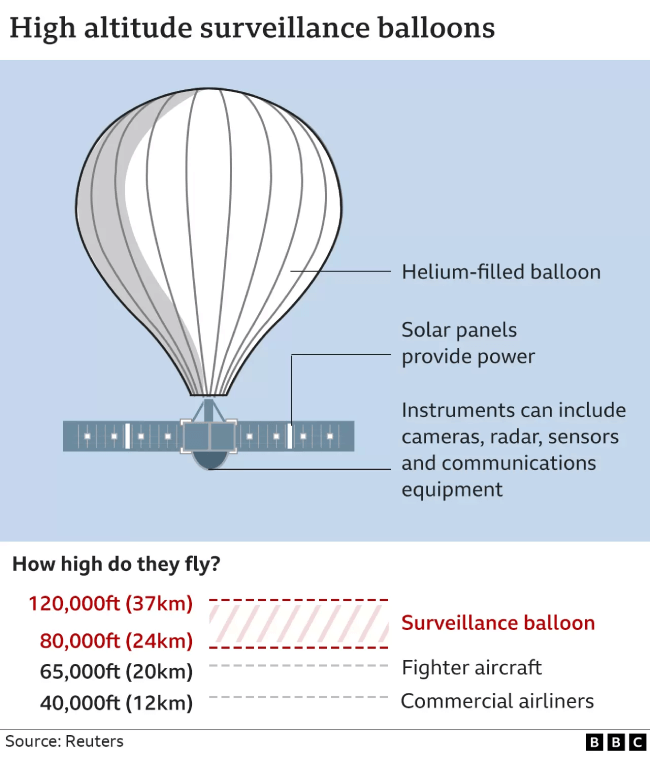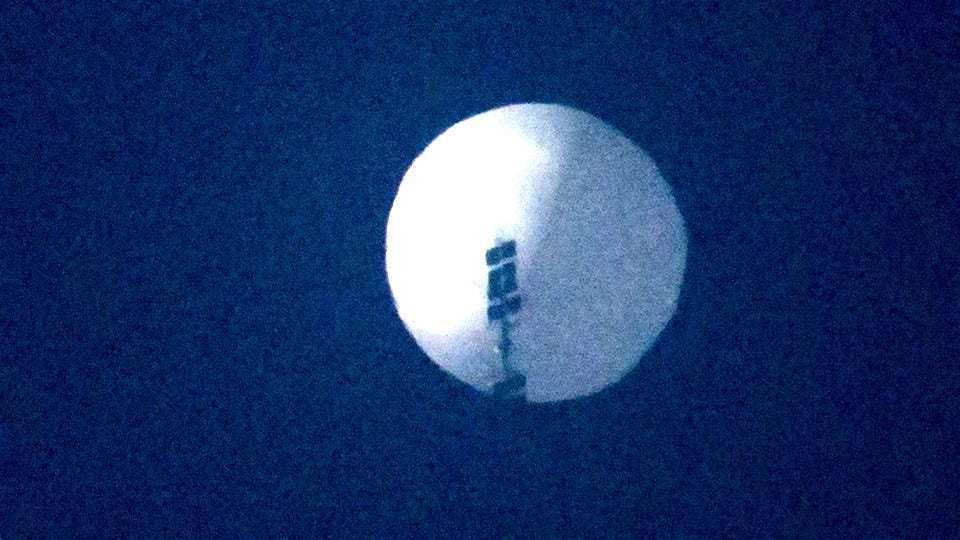Is everybody high? High altitude airships, objects, and balloons (HAA, HAO, HAB), oh my!
Is it China or extraterrestrials that say HAA, HAO, and HAB to the USA?
Introduction
These days there is a lot of information, misinformation, and disinformation on the topics of unidentified flying objects (UFOs), unidentified aerial phenomena (UAP), and balloons. I will not say that I am expert, but I would like to recommend a framework for evaluating each instance of these UFOs over the past few weeks to months.
Background
Terminology
The UFOs go by several different terms: HAA, HAO, HAB, UFO, UAP, and others. For now I will refer to all the above simply as HAOs, which can describe any powered platforms operating 20 km to 50 km (65,600 ft to 164,000 ft, or 12 to 31 miles) for weeks to months at a time [1]. There is no consensus on these altitudes, but these are higher than 6 km to 12 km altitudes of passenger aircraft. HAO designs tend to be optimized to take advantage of less intense wind speed above the jet stream, especially for telecommunications relays and ground observation. Different HAO designs have been used since the 1930s, but the technology necessary to keep these platforms aloft for weeks while carrying heavy payloads has emerged rather recently.
Hobby Balloons
There is no set definition for a hobby balloon, but it is assumed these operate at the same altitudes. The cheaper pico balloons will be about 3 feet in diameter and will operate between 6 km and 12 km. Depending on the country, the balloon may be required to have a GPS tracker, WSPR protocol signal on HF, ASPR protocol signal on VHF/UHF, or an ADS-B beacon.
Chinese Dual-Use Military/ Commercial HAOs
The Guardian reported on 2023-07-07 at 23:27 GMT that the US Air Force has been publicly aware of China’s “military-capable” HAOs since 2019 [2]. For completeness, here is a quick sampling of known HAO sightings out of China prior to 2022:
May 2019: Jimu-1, 2, and 3 HAOs (technically aerostats) achieved maximum altitude of 7.5 km (24,600 ft) [3]. These HAOs were useful for collecting weather data, which is congruent with China’s claims.
June 2019: Indian military officials report that China is using its weather balloons to conduct military surveillance operations over India [4]. Reports indicate that the HAOs resemble Russian-made Augur-RosAero aerostats that are capable of carrying payloads (2,000 kg) up to 7 km. These HAOs measured about 40 m in length, 14 m in diameter, which is larger than the Jimu series. Officials from China’s National Defence University deny spying on India [5].
There are several other web pages that have been indexed between 2019 and 2022 that appear to have been altered or replaced when searching for “China balloon”. All searches for “China spy balloon” are redirected to 2023. It is important to note that references to the US “mass surveillance balloons” are easier to locate in archived websites than “Chinese spy balloon”.
Chinese Military Drones
As far back as 2017, China tested the deployment of small spy drones from a HAO at an altitude of 20 km (12,700 miles), which hints at another concept of operation (CONOP) that could be in play [6].
HAO Design
The design will be driven by the purpose of the HAO. The simplest design is the weather balloon, which merely needs power for basic meteorology instruments. Military balloons based on civilian designs include the weather radar that can also be used for military applications, as identified by NATO as far back as 2020-11-25.
Image source: [3]
Surveillance balloons, especially military grade ones, will be larger. The image below is similar to the Chinese HAOs deployed over the Philippines, Japan, and USA in late 2022 to early 2023. The most obvious difference will be the large solar panels attached to a metal superstructure, which will house any number of sensor and communication equipment.
Image source: [7]
Most HAOs to this point have a “balloon” section that is spheroid-shaped, with many different payload designs optimized for weather, surveillance, communications, or other. As these systems carry more sophisticated payloads it is common to see long solar panels mounted orthogonal to the payload superstructure for aerodynamic stability. Payload design is rather intuitive. Cameras that need unobstructed view of the earth below will simply point downwards. Communications payloads may use flat panels to house antennas pointing in all directions, resulting in a rectangular or octagonal shape [8].
Recent Sightings
2023-01-28: A larger HAO entered the Alaska Air Defense Identification Zone (ADIZ) and is tracked over the United States. F-22 Raptors from Langley AFB, Virginia (FRANK-1 and FRANK-2) intercepted and destroyed the target with an AIM-9X off the coast of Myrtle Beach, South Carolina at an altitude of 60,000 feet (18 km) on 2023-02-03. The object looked like a known Chinesa HAO as shown in the figure below.
2023-02-02: A HAO of unknown size is declared by Chinese government as a research balloon that was blown off course towards Costa Rica, Colombia, and Venezuela. This HAO was believed to operate just below 55,000 feet (17 km).
2023-02-09: A smaller HAO entered the Alaska ADIZ at an altitude of 40,000 ft (12 km) and was shot down by an F-22 and AIM-9X a day later as a potential threat to commercial flights.
2023-02-11: A smaller HAO was tracked and shot down over Canadian airspace by an F-22 and AIM-9X. This HAO has been described as a metallic cylinder.
2023-02-11: A smaller HAO with octagonal shape is shot down at 20,000 ft (6 km) by an F-16C. This could could have been a telecommunications relay.
Between 2023-02-12 and 2023-02-19 there were additional sightings over Rizhao, China; Romania; Shijiahuang, China; and Honolulu, Hawaii.
Military Utility
How much military utility does a HAA, HAO, or HAB provide? Why not use a drone aircraft or a satellite? A properly designed HAx will look like a weather balloon, or if it looked more nefarious due to the large sensor suite it might not matter because the air vehicle would be beyond weapons range for all but the most exquisite weapons systems. The most useful application of a balloon would be as a psychological operation designed to invoke fear, uncertainty, and doubt into the minds of citizens watching the events on the media, and in the minds of international observers wondering who is indeed the most powerful nation on earth [9].
References
Oliveira, Flavio; de Melo, Francisco; Devezas, Tessalano. “High Altitude Platforms - Present Situation and Technology Trends”. Journal of Aerospace Technology. Vol 8, No 3, pp 249-262. Jul-Sep 2016. doi:10.5028/jatm.v813.699. https://www.scielo.br/j/jatm/a/JQv95PgKcDCtrn95vLLV8qN/?format=pdf&lang=en. Accessed 16 Feb 2023.
Wong, Julia. “Chinese spy balloon seen above Hawaii and Florida in 2019, report says”. The Guardian. 7 Feb 2023. https://www.theguardian.com/us-news/2023/feb/07/chinese-spy-balloon-us-2019-trump. Accessed 16 Feb 2023.
Yuan, Li. “Giant Balloon to Garner Climate Data”. Chinese Academy of Sciences. https://english.cas.cn/newsroom/news/201905/t20190527_210635.shtml. 27 May 2019. Accessed 16 Feb 2023.
Colonel Bhat, Vinayak. “China is using hi-tech balloons to spy on India from Tibet”. The Print. https://theprint.in/defence/china-is-using-hi-tech-balloons-to-spy-on-india-from-tibet/251246/. 18 Jun 2019. Accessed 16 Feb 2023.
Zee Media Bureau. “Balloons along China border not for spying on India, claims Global Times“. 21 Jun 2019. https://zeenews.india.com/india/balloons-along-china-border-not-for-spying-on-india-claims-global-times-2213257.html. Accessed 17 Feb 2023.
Chen, Stephen. “China tests new spy drones in near space ‘death zone’”. South China Morning Post. 31 Oct 2017. https://www.scmp.com/news/china/society/article/2117709/china-tests-new-spy-drones-near-space-death-zone. Accessed 17 Feb 2023.
Mitchell, Robin. “Chinese Weather Balloon? Not Likely!”. Electropages. 9 Feb 2023. https://www.electropages.com/blog/2023/02/chinese-weather-balloon-not-likely. Accessed 17 Feb 2023.
Rasool, Nouman; Kama, Huang; et al. “A Low Profile High Gain Ultra Lightweight Circularly Polarized Annular Ring Slot Antenna for Airborne and Airship Applications”. IEEE Explore. Volume 7. 25 October 2019. doi:10.1109/access.2019.2949683. http://ieeexplore.ieee.org/stamp/stamp.jsp?tp=&arnumber=8883259. Accessed 16 Feb 2023 via membership access.
Flynn, Michael and Cutler, Boone. “The Citizen's Guide to Fifth to Generation Warfare (CG5GW)”. Boone Cutler Media. 28 December 2022.







